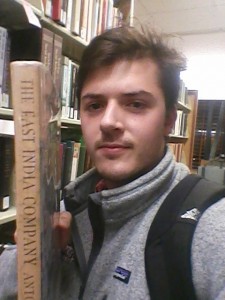This ornate piece is a silver gilt tea caddy from China likely used by an English elite to hold tea leaves. (ca. 1760)
Can currently be found a the Victoria and Albert Museum in London.
http://collections.vam.ac.uk/item/O73977/tea-caddy-unknown/
The book I choose for this second Shelfie exercise is entitled, Empires at War: 1911-1923, and it examines the conflict of WWI through the lens of empire as opposed the lens of nation-states. The book expands the generally accepted timeline of WWI (1914-1918) to focus on 1911-1923 and the catalysts and repercussions of this global war. The book begins with an introduction that explains the scope work, and then is broken into chapters written by different contributors which discuss the Ottoman, Italian, Russian, German, Austria-Hungarian, French, Japanese, Chinese, United States, and other empires. The chapter on the Russian Empire is written by Lafayette College’s very own Joshua Sanborn. In addition to the text, the book includes a nice array of maps that helps conceptualize the global extent of WWI.
I found this book by using the keyword phrase, “colonial powers in WWI” in a library catalogue search. The book is located in the Upper Level of Skillman library in a section that seemed to be entirely devoted to books on WWI. I was drawn to this book because of its subject matter, and its relation to the topics we have discussed in class. I like the structure of the work and believe it could be a useful supplement to class in the future.
Gerwarth, Robert, and Erez Manela, eds. Empires at War: 1911-1923. New York: Oxford UP, 2014. Print.
Wild, Antony. The East India Company: Trade and Conquest from 1600. London: HarperCollins, 1999.
I began my shelfie search looking for a book about trade in early modern history, but my searches did not produce many promising results. I then refined my search focusing specifically on The East India Company, and that is what brought me to this book, The East India Company: Trade and Conquest from 1600 by Antony Wild. The book gives a complete overview of the establishment of the East India Company, and the eventual trading empire it was able to create. Wild’s work also delves into the specific daily operations of the business, and how the company was eventually absorbed by the British Crown. I also found it compelling how the book uses many pictures and illustrations. They are very similar to the 100 objects we look at in class, and I think they add an extra depth to story of the East India Company. The book resides in the upper level of the library and is surrounded by other books about the formation of India and British colonization of India. 